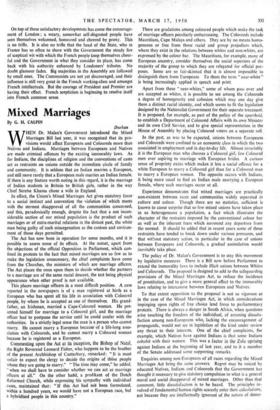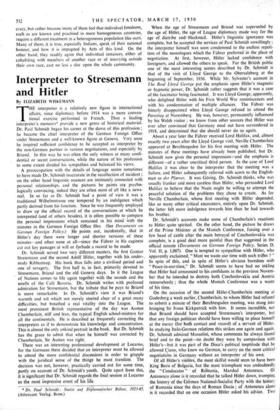Mixed Marriagei
By G. H. CALPIN Durban
WHEN Dr. Malan's Government introduced the Mixed Marriages Bill last year, it was recognised that its pro- visions would affect Europeans and Coloureds more than Natives and Indians. Marriages between Europeans and Natives are made criminal offences by the existing immorality laws. As for Indians, the disciplines of religion and the conventions of caste act as restraints on unions outside the immediate circle of family and community. It is seldom that an Indian marries a European, and still more rarely that a European male marries an Indian female. If there is any feature worth noting in this regard, it is the marriage of Indian students in Britain to British girls, rather in the way Chief Seretse Khama chose a wife in England.
In effect, the Union's Mixed Marriages Act gives statutory force to a social instinct and convention the violation of which meets with the sternest disapproval of all the communities concerned, and this, paradoxically enough, despite the fact that a not incon- siderable section of our mixed population is the product of such marriages or of extra-marital relations in the distant past, the white man being guilty of such miscegenation as the custom and environ- ment of those days permitted.
The Act has now been in operation for some months, and it is possible to assess some of its effects. At the outset, apart from the objections of the official Opposition in Parliament, which con- fined its protests to the fact that mixed marriages are so few as to make the legislation unnecessary, the chief complaints have come from the Churches, the ministers of which are marriage officers. The Act places the onus upon them to decide whether the partners to a marriage are of the same racial descent, the test being physical appearance when other proof is not available.
This places marriage officers in a most difficult position. A case reported in the newspapers is of a man registered at birth as a European who has spent all his life in association with Coloured people, by whom he is accepted as one of themselves. His grand- father, an Irishman, married a Cape-Coloured woman. He pre- sented himself for marriage to a Coloured girl, and the marriage officer had to postpone the service until he could confer with the authorities. In a strictly legal sense the man is a person who cannot marry. He cannot marry a European becaUse- of a life-long asso- ciation with Coloureds, and he cannot marry a Coloured woman because he is registered as a European.
Commenting upon the Act at its inception, the Bishop of Natal, the Right Reverend Leonard Fisher, who happens to be the brother of the present Archbishop of Canterbury, remarked: " It is most unfair to expect the clergy to decide the origins of thhse people whom they are going to marry." " The time may come," he added, " when we shall have to consider whether we can act as marriage officers at all." On the other haftd, a predikant of the Dutch Reformed Church, while expressing his sympathy with individual cases, maintained that: "If this Act had not been formulated, within a hundred years, we would have not a European race, but a hybridised people in this country."
There are gradations among coloured people which make the task of marriage officers peculiarly embarrassing. The Coloureds include Mauritians, Cape Malays and others. They are by no means homo- geneous or free from those racial and group prejudices which, where they exist in the relations between whites and non-whites, are expressed by the colour bar. The Mauritian, for example, many of European ancestry, consider themselves the social superiors of the majority of the group to which they are relegated for official pur- poses. Some are so fair-skinned that it is almost impossible to distinguish them from Europeans To them the term " near-white" is being increasingly applied in speech and print.
Apart from these " near-whites," some of whom pass over and are accepted as whites, it is possible to see among the Coloureds a degree of homogeneity and cohesion which may one day give them a distinct racial identity, and which seems to fit the legislation designed by the Nationalist Government for their separate treatment. It is proposed, for example, as part of the policy of the apartheid, to establish a Department of Coloured Affairs with its own Minister and its own Civil Service, and to give special representation in the House of Assembly by placing Coloured voters on a separate roll.
In the past, as was to be expected, unions between Europeans, and Coloureds were confined to an economic class in which the two associated in employment and in day-to-day life. Almost invariably, it is the European man who chooses a Coloured girl, few Coloured . men ever aspiring to marriage with European brides. A curious sense of propriety exists which makes it less a social offence for a white European to marry a Coloured girl than for a Coloured man to marry a European woman. The opposite occurs with Indians, it being more usual to find an Indian male marrying a European female, where such marriages occur at all.
Experience demonstrates that mixed marriages are practically non-existent between races and communities widely separated in culture and colour. Though there are no statistics, sufficient is known to cause surprise that so few mixed unions have taken place in so heterogeneous a population, a fact which illustrates the character of the restraints imposed by the conventional colour bar as well-as the inherent fears which surround any departure from the normal. It should be added that in recent years some of these restraints have tended to break down under various pressures, and that without statutory action, in particular in the case of unions between Europeans and Coloureds, a gradual assimilation would inevitably take place.
The policy of Dr. Malan's Government is to stay this movement by legislative measures. There is a Bill now before Parliament to extend the immorality laws to include illicit unions between Whites and Coloureds. The proposal is designed to add to the safeguarding provisions of the Mixed Marriages Act, to reduce the incidence of prostitution, and to give a more general effect to the immorality laws relating to intercourse between Europeans and Natives.
To that extent opposition to the proposal is not so vigorous as in the case of the Mixed Marriages Act, in which considerations impinging upon rights of free choice lend force to parliamentary protests. There is always a danger in South Africa, when questions arise touching the freedom of the individual, of arousing dissatis- faction among non-Europeans who, lacking the encouragement of propaganda, would not see in legislation of the kind under review any threat to their interests. One of the chief complaints, for example, which Natives have against Indians is that some Indians cohabit with their women. This was a factor in the Zulu uprising against Indians at the beginning of last year, and to it a member of the Senate addressed some supporting remarks.
Enquiries among non-Europeans of all races regarding the Mixed Marriages Act bring the same answers. Regret may be voiced by educated Natives, Indians and Coloureds that the Government has thought it necessary to give statutory compulsion to what is a general moral and social disapproval of mixed marriages. Other than that comment, little dissatisfaction is to be heard. The principles in volved of fundamental human rights scarcely enter their calculations, not because they are intellectually ignorant of the nature of demo-
cracy, but rather because many of them feel that individual freedoms, such as are known and practised in more homogeneous countries, require a different treatment in a heterogeneous population like ours. Many of them, it is true, especially Indians, speak of their national honour, and how it is impugned by Acts of this kind. On the other hand, they readily agree that individual instances, either of cohabiting with members of another race or of marrying outside their own race, cast no less a slur upon the whole community.



































 Previous page
Previous page